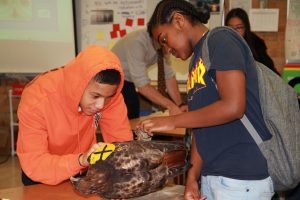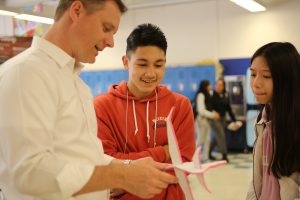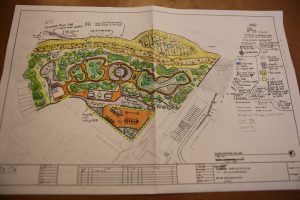“I will remember how to look at different perspectives and consider what people want.”
– 7th grade student, Showalter Middle School, Tukwila, WA
“What we did was a real-life situation and had a real purpose.”
– 7th grade student, Eckstein Middle School, Seattle, WA
I think my teacher should teach this next year because it deals with a very local issue and it’s engaging and interactive.
– 8th grade student, Nautilus K-8, Federal Way, WA
“It gives students the opportunity to actually learn about something that’s happening right now. And it gives them opportunity to engage with their peers and talk to them and collaborate.”
– High school biology student, Highline Public Schools, Burien, WA

Photo by Jeff Nachtigal
At Showalter Middle School, student groups preparing for a mock Port Commissioner meeting developed and refined their point of view by working with guest professionals from King County and the Port of Seattle. A wastewater specialist helped a group consider the impact of their park’s design on the Duwamish River. Another group described their plans for an underwater aquarium and received constructive guidance about the feasibility of their plan. Across the room, the Port of Seattle’s Director of Communications asked students how their criteria for selecting the best park would balance economic, environmental, and community goals.
A few miles away, 8thgrade designers of an efficient airplane explained the features beneath their plane’s cherry-blossom livery to a local pilot who had come to critique their work during a school-wide family presentation night at Cascade Middle School. Prompted by the pilot, students discussed the value of winglets, passenger seating arrangements, route selection, and other calculated considerations that went into creating a more sustainable airline.
Further south in Des Moines, WA, biology students at Mt. Rainier High School filled tables in the common room with presentations, with each group describing to visitors how their Wildlife Management Plans would help avoid bird strikes at Sea-Tac International Airport. Students at Table 3 presented a mitigation plan to remove bird-attracting plants with berries from the airport habitat and only use scare tactics such as flares and pyrotechnics in the case of emergencies. They fielded questions from an audience that included students from other science classes and Sea-Tac’s ecologist.
* * * * * * * * *

Photo by Jeff Nachtigal
This spring, nearly a thousand students engaged in project-based learning that was focused on real-life challenges faced by the Port of Seattle. The goal was to increase awareness of the Port’s role in King County communities, particularly those near the airport, seaport, and other port activities. The richness of student experiences, reflected a uniquely cooperative approach to designing the units that included teachers, professionals at the Port of Seattle, community experts, and Educurious.
Projects were developed in three different subject areas: 7thgrade social studies, 8thgrade math, and high school biology. Each project began with a meeting that brought teachers and Port professionals together to discover interesting intersections between ongoing challenges at the Port and teachers’ subject matter goals. For example, biology teachers were introduced to Sea-Tac Airport’s wildlife biologist and ecologist. After exploring many aspects of their work – from wetland management to raptor chick relocation – the idea for a project about preventing birds from striking aircraft was born.
Teachers then advanced the project idea into a structured unit outline that met learning standards and engaged students in grappling with a real-world problem. Once curriculum writing began in earnest at Educurious, we continued to draw on the Port’s expertise as we developed resources and a network of both Port and community partners.

Photo by Jeff Nachtigal
Once the units were ready to pilot, all partners were invited to participate in classrooms throughout the project process. Port professionals and other community members visited classrooms as expert speakers, worked directly with student groups in the development of their projects, and observed and gave feedback on students’ final presentations.
This breadth of engagement from the Port of Seattle and surrounding communities fostered a sense of authenticity that many students felt deeply. Students reported the work felt both “real” and meaningful, that learning about their community was important, and that the presence of Port and community professionals increased their motivation to do good work.
As students learned how challenging it can be to balance stakeholders and divergent goals to keep communities safe, productive, and ecologically healthy, they were supported by the very kind of cross-institutional cooperation to which their projects aspired.
For more information on this free curriculum or project-based learning, please contact Sara Nachtigal.

